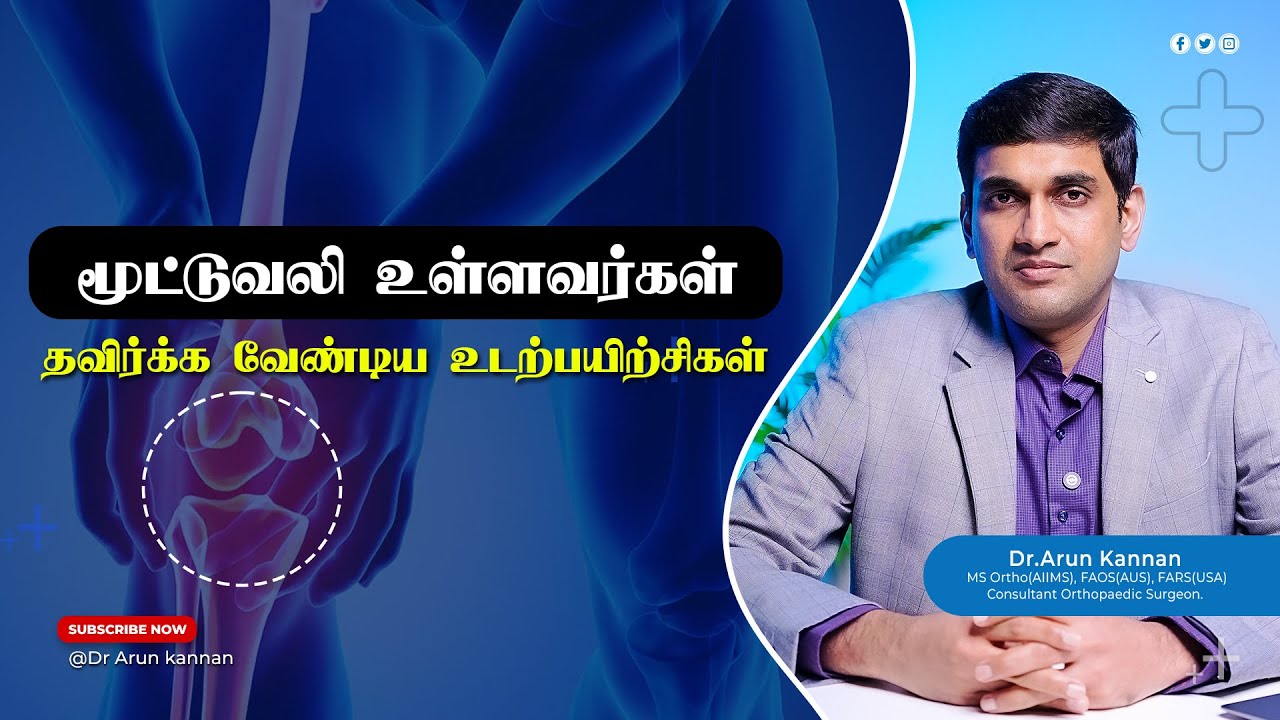 16 July, 2025
16 July, 2025
Best Knee Replacement in Chennai: Exercises to Avoid When You Have Knee Pain or Arthritis
Knee pain and arthritis are common problems, especially for individuals over the age of 45 or 50. Many people suffering from these conditions often wonder what exercises they can safely perform to improve their joint health without worsening their pain. Understanding which exercises to avoid is just as important as knowing which ones to do.
In this comprehensive guide, I, Dr. Arun Kannan, an orthopedic surgeon from Jayam Ortho Care, Kodambakkam, Chennai, will walk you through the exercises that can aggravate knee pain and arthritis. I will explain why certain movements increase joint stress and inflammation, and suggest safer alternatives to help you maintain mobility and reduce pain.
Understanding Knee Osteoarthritis and Its Impact
Knee osteoarthritis is a degenerative joint disease that primarily affects the cartilage inside the knee joint. Over time, this cartilage wears down, leading to pain, stiffness, and reduced function. Typically, knee osteoarthritis becomes noticeable after the age of 40, 45, or 50. However, these days, many younger individuals in their early 40s also experience signs of this condition due to various contributing factors.
One of the primary causes of accelerated knee osteoarthritis is excessive mechanical load on the knee joint. When the weight-bearing capacity of the knee is overwhelmed, the cartilage deteriorates faster. This is why body weight plays a crucial role in the progression of knee arthritis. Excess body weight increases the pressure on the knee joint, hastening cartilage wear and tear.
How Mechanical Load Affects the Knee
When you stand or walk, the forces acting on your knee joint can be several times your body weight. For example, standing with your weight evenly distributed between both legs generates less stress on each knee. But if you bend your knees deeply or stand on one leg, the load on the knee joint multiplies considerably.
For instance, squatting deeply or sitting in an Indian-style toilet position causes the knee to bend fully, increasing the pressure on the joint by up to five times your body weight. Similarly, lunges and stair climbing also place significant mechanical stress on the knee joint. These activities can accelerate cartilage damage in people with existing knee osteoarthritis.
Exercises to Avoid for Knee Pain and Arthritis
Understanding which exercises to avoid is critical for managing knee osteoarthritis effectively. Certain movements increase knee joint load excessively and worsen pain and inflammation. Below, I detail the most common exercises that patients with knee pain or arthritis should avoid or modify.
1. Full Squats
Full squats involve bending your knees deeply until you are sitting almost parallel to the ground or lower, similar to sitting on an Indian-style toilet. While squats are often recommended for strengthening the legs, full squats place tremendous pressure on the knee joint—sometimes up to five times your body weight.
For individuals with knee osteoarthritis, performing full squats can worsen joint pain and accelerate cartilage degeneration. Therefore, I strongly advise avoiding full squats if you already have knee pain or arthritis.
2. Lunges
Lunges involve stepping forward or backward and bending your knees to lower your body. This exercise is popular for fitness and weight loss. However, lunges place uneven loads on the knees, especially when the knees bend beyond 45 degrees, causing increased stress on the joint.
For younger people without knee problems, lunges can be safe and effective. But if you have knee osteoarthritis, lunges can exacerbate pain and joint damage. It’s best to avoid lunges or consult your doctor before including them in your routine.
3. Jumping Exercises (Jumping Jacks)
Jumping jacks and other high-impact jumping exercises create sudden, repetitive forces on the knee joint. These forces can aggravate inflammation and damage the cartilage further in arthritic knees. While jumping exercises may help with weight loss and cardiovascular fitness, they are not suitable for those with knee pain or arthritis.
Instead, low-impact aerobic exercises such as walking or cycling are safer alternatives for maintaining fitness without harming your knees.
4. Long-Distance Running and Marathons
Running, especially long-distance running like marathons, places repetitive high loads on the knee joints. For people with knee osteoarthritis, this repeated stress can accelerate joint wear and increase pain. While running is a popular form of exercise, it is advisable to avoid long-distance running if you have knee pain or arthritis.
If you enjoy running, consider switching to shorter distances or low-impact alternatives like swimming or using an elliptical trainer.
5. Hiking and Excessive Stair Climbing
Hiking, particularly uphill hiking and stair climbing, involves repeated bending of the knee joint under load. This action is similar to lunges and squats, increasing the mechanical stress on the knee cartilage. Excessive hiking or stair climbing can worsen knee pain and accelerate arthritis progression.
Moderation is key. If you enjoy hiking, try to limit the duration and intensity, and avoid steep climbs that require deep knee bending.
Why Do These Exercises Worsen Knee Pain?
The common factor among the exercises listed above is that they increase the mechanical load on the knee joint, especially when the knee is deeply bent or bearing excessive weight. This increased load compresses the already damaged cartilage and irritates the joint lining, leading to more inflammation, pain, and reduced mobility.
Research shows that deep knee bending exercises can increase the load on the knee joint by three to five times your body weight. For someone with knee osteoarthritis, this excess load accelerates cartilage breakdown and worsens symptoms.
Safe Exercise Alternatives for Knee Arthritis
Exercise remains an important part of managing knee arthritis. The key is to choose activities that strengthen the muscles around the knee, improve joint mobility, and maintain cardiovascular fitness without overloading the joint.
1. Partial Squats or Mini Squats
Instead of full squats, partial or mini squats where you bend the knees only 15 to 20 degrees are safer for arthritic knees. These squats strengthen the quadriceps muscles without placing excessive load on the cartilage.
Perform mini squats by standing with feet shoulder-width apart, slowly bending your knees slightly, and then returning to a standing position. Avoid going too deep.
2. Walking
Walking is one of the best low-impact exercises for knee arthritis. Walking helps maintain joint mobility, strengthens muscles, and improves cardiovascular health. However, it is important to avoid excessive walking that causes pain or fatigue.
For mild arthritis, 20 minutes of walking per day is beneficial. You can split this into two 10-minute sessions if needed. Avoid long-distance walking or walking on uneven terrain that stresses the knees.
3. Swimming and Water Aerobics
Swimming and water exercises provide resistance training with minimal joint load. The buoyancy of water reduces stress on the knees while allowing you to strengthen muscles and improve flexibility.
4. Cycling
Cycling on a stationary bike or flat terrain is another excellent low-impact exercise. It strengthens the quadriceps and hamstring muscles, which support the knee joint, without excessive joint compression.
5. Strengthening and Flexibility Exercises
Targeted exercises to strengthen the muscles around the knee help reduce joint load and improve stability. These include straight leg raises, hamstring curls, and calf raises. Stretching exercises improve joint flexibility and reduce stiffness.
Additional Tips for Managing Knee Osteoarthritis
Beyond exercise, managing knee osteoarthritis involves a multidisciplinary approach. Here are some additional strategies to help protect your knees and reduce pain:
- Weight Management: Maintaining a healthy weight reduces the load on your knee joints and slows arthritis progression. Even losing a small amount of weight can make a significant difference.
- Use of Supportive Devices: Knee braces and cushioned footwear can help reduce joint stress during activities.
- Diet and Nutrition: A balanced diet rich in anti-inflammatory foods supports joint health.
- Medications and Injections: Pain relievers, anti-inflammatory medications, and joint injections can provide symptom relief.
- Consultation with Specialists: Regular follow-up with an orthopedic specialist ensures appropriate management and timely intervention.
Frequently Asked Questions (FAQ)
Can I do squats if I have knee arthritis?
Full squats are not recommended for people with knee arthritis as they place excessive pressure on the knee joint. However, partial or mini squats with limited knee bending (15-20 degrees) can be beneficial and safer.
Is walking good for knee pain and arthritis?
Yes, walking is a low-impact exercise that helps maintain joint mobility and muscle strength. It is advisable to walk for about 20 minutes daily, split into shorter sessions if needed. Avoid overexertion or walking on uneven surfaces.
Can I perform lunges if I have knee pain?
Lunges place uneven and high loads on the knees, which can worsen arthritis symptoms. It is best to avoid lunges or consult a healthcare professional before including them in your routine.
Are jumping exercises beneficial for knee osteoarthritis?
Jumping exercises like jumping jacks are high-impact and can aggravate knee pain and inflammation. These exercises should be avoided if you have knee arthritis.
Is long-distance running safe for people with knee arthritis?
Long-distance running is not recommended for individuals with knee arthritis as it causes repetitive high loads on the knee joint, accelerating cartilage damage.

